NorthEast Radio Watch 12/15/2025: NYC Morning Shakeup
In this week’s issue… NYC morning shows exit - Carton back amidst WFAN shakeup - FM signing off in Canada - More radio centennials
Text and photos by SCOTT FYBUSH
It’s a funny thing – from our alternate home base in Fort Wayne, we’ve spent lots of time over the years going south, west and east to explore the broadcasting terrain of Indiana and vicinity. But there’s a sizable market just two hours to the north up I-69 that had been mostly a blank slate for us, at least until the summer of 2017 when we finally made the journey to Lansing, Michigan to see what there was to be seen.
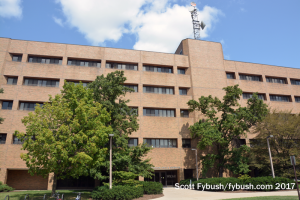
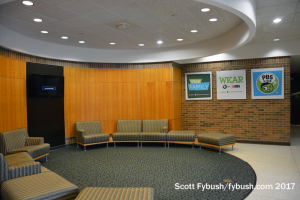
In addition to being Michigan’s state capital, Lansing – well, neighboring East Lansing, anyway – is the home of Michigan State University, which has a very long history in broadcasting, making it an ideal first stop on a busy afternoon of Lansing broadcast tourism.
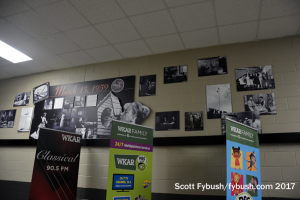
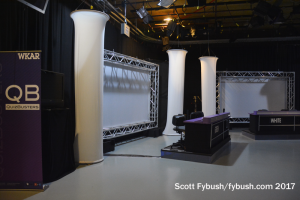
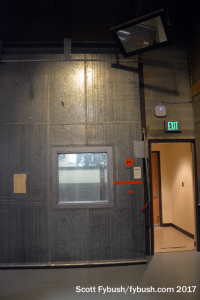
The Communication Arts and Sciences Building on the MSU campus is home now to all three of WKAR’s services – WKAR (870), WKAR-FM (90.5) and WKAR-TV (Channel 23) – and we start downstairs on the TV side of the operation, where several large studios (with extremely impressive metal doors) line a long hallway decorated with moments from WKAR’s history.

MSU (then Michigan State College) was a UHF educational TV pioneer, putting WKAR-TV on the air in January 1954 on channel 60, behind only KUHT in Houston and the short-lived KTHE in Los Angeles. UHF was a perilous place to be back then, and Michigan State wanted to move to the VHF dial, where channel 10 was allocated but not yet granted in nearby Onondaga.
In 1959, a deal was struck – channel 10 would share time between commercial WILX-TV and Michigan State, which changed its TV calls to WMSB and remained a partial occupant of channel 10 for 13 years. With UHF more viable, the station went full-time once again in 1972 in its current form, building a new 1000-foot tower east of the campus for its new channel 23 facility. (As WMSB, it shared the WILX-TV transmission facility in Onondaga, which we’ll show you in next week’s installment.) Its studios moved a decade later to this facility, leaving behind a Quonset hut where they’d operated since the channel 60 days.
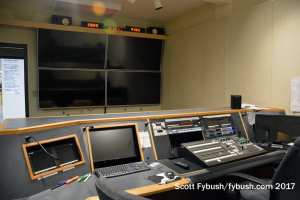
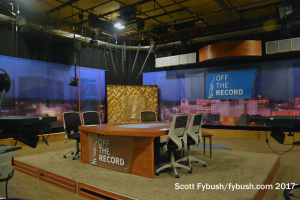
There’s a good amount of local production in these studios; when we visit, one of them is set up for the “Quizbusters” high school quiz competition, while another is configured for “Off the Record,” WKAR’s statewide public affairs show focusing on state politics.
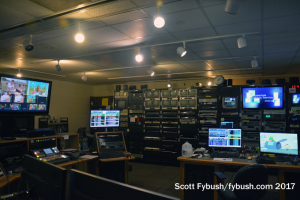
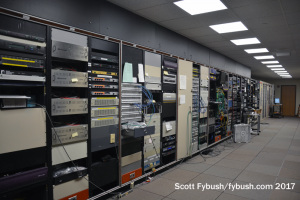
Around the corner from the studios, there’s a spacious rack room where old analog gear is slowly being decommissioned, and then a master control facility with big windows looking out to the academic part of the communications building.

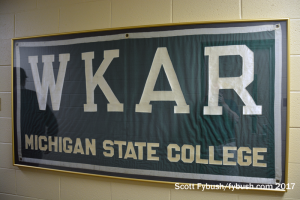
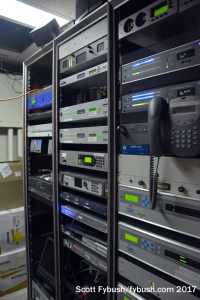
WKAR’s radio operations are upstairs, and here too there’s lots of history. WKAR’s AM signal first took air in 1922, following experimental transmissions that date back to 1917. As with so many educational stations, it got a raw deal from the FRC and then the FCC, being forced to operate daytime-only, eventually sharing 850 and then 870 with WWL in New Orleans.
WKAR-FM dates back to 1948, and now operates as an 85 kW superpower signal that’s heard widely across southern and central Michigan from its perch just below WKAR-TV’s antenna.
Today, WKAR(AM) is the full-time news and talk service, with a fairly recent translator providing 24-hour FM coverage to augment the daytime-only AM signal from a site on the edge of the East Lansing campus.
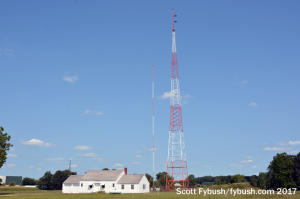
That site, shown at left, dates to 1948, when the AM station moved from its longtime home right on the campus. (The FM started here before moving to its current site in 1959.)
The translator, which operates from the FM tower, had been on 94.5 when we visited in 2017, but very recently upgraded to a better signal at 105.1.
WKAR(AM) also has local Spanish-language programming on weekend mornings; the FM, meanwhile, is a split service that carries the big NPR newsmagazines and “Current State” alongside plenty of classical music the rest of the day.
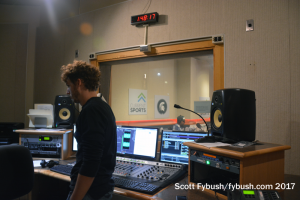
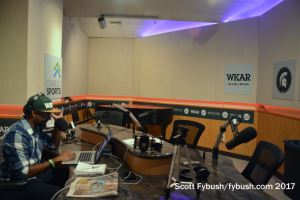
WKAR’s radio studios underwent some renovations in recent years, including a new lobby area that doubles as a green room for guests waiting to go on the local talk shows, “Current State” and “Current Sports,” the latter of which is on the air from a spacious talk studio when we stop by this Friday afternoon. (That Axia-equipped control room for the “Current” shows is fairly new, too.)
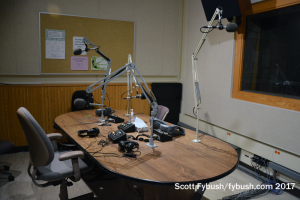
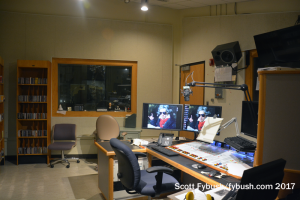
The WKAR radio studios wind their way back in a big loop – there’s an older talk studio back here, a rack room, and the music studios for WKAR-FM as well.

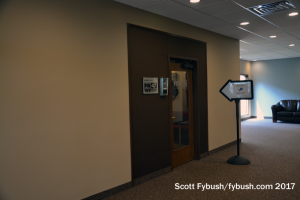
From here, our afternoon agenda (with big thanks to our friend Dan Kelley, head of the Michigan Association of Broadcasters and our day’s tour guide) takes us quickly through Lansing’s commercial TV stations, starting just north of downtown at the Scripps-owned Fox affiliate, WSYM (Channel 47).
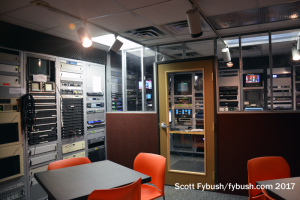

This compact facility is arranged mostly along one long hallway, which passes the WSYM master control area (now walled off and shared with a staff lounge/greenroom space) on the way to a small studio where WSYM’s local news used to originate. The news on the Fox affiliate now comes from WILX, the NBC affiliate, and so things are quieter these days in the production control room across the hall.


The former news studio is now home only to the “Morning Blend” inserts that WSYM produces during the morning newscast, which otherwise comes from WILX; half the studio has been walled off now as a production space. And the former newsroom, at the end of the hall, is now a sales and office area.


Our next stop, fittingly enough, is down at WILX’s studios, in a commercial area south of Lansing. WILX has been here only since the early 1990s, when it consolidated operations that had been split between a main studio in Jackson and a newsroom in downtown Lansing.


Now owned by Gray Television, WILX’s operations here on American Road had recently been renovated: there’s a newsroom off to the right of the lobby, and a control-room core in the center of the building that handles both master control and production control functions. The studio, at the back of the building, had just gotten a new set when we visited in the summer of 2017; while the set was being built, the news came from a temporary set across the hall in the cafeteria.
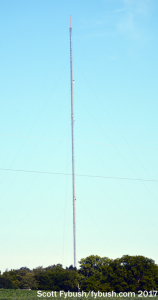
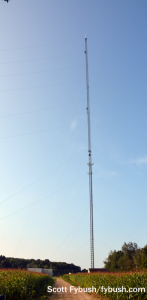
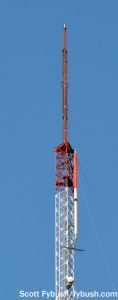
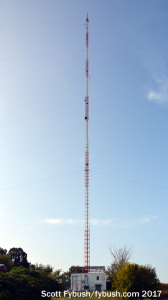
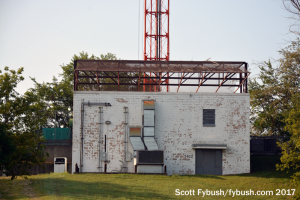
And we’ll end this installment of Lansing broadcast visits by jumping a day ahead to our Saturday morning, when we made an early drive south of Lansing to Onondaga, where several of the city’s TV stations have their towers.
WSYM has been down here since it signed on in the 1980s, and so has the market’s ABC affiliate, WLAJ (Channel 53), a couple of miles to the east – but long before it ever made it to the air, the channel 10 facility was the first TV station here in 1959. The building that was shared by WILX and then-WMSB is still here, still used by WILX – and it’s still transmitting on VHF channel 10, covering the broad swath of central Michigan that stretches from the Indiana border north past Lansing.
But it’s not the oldest TV station in the market, not by a long shot – and in next week’s installment, we’ll show you who got there first!
Thanks to Dan Kelley for the tours!

As we announced a few weeks ago, the 2026 edition of the Tower Site Calendar will be the last.
We began publishing it 25 years ago, and the broadcast landscape is radically different now.
Radio World just ran an excellent article about us if you want to know more.
Once it’s gone, that’s it. We won’t be printing any more.
Thank you to everyone who saw our announcement and rushed to buy it. We appreciate you.
(There are some calendars from previous years if you want more of a tower photo fix — all under $5.)
But don’t wait to get this year’s Tower Site Calendar — buy it now!
We are selling the Broadcast Historian’s Calendar again this year, but we have that in an even smaller quantity — definitely don’t hesitate for that.
And visit the Fybush Media Store to check out our selection of books and videos, too!
And don’t miss a big batch of Lansing IDs next Wednesday, over at our sister site, TopHour.com!
Next week: Lansing, part II
In this week’s issue… NYC morning shows exit - Carton back amidst WFAN shakeup - FM signing off in Canada - More radio centennials
In this week’s issue… Veteran newsman returns - Remembering NY's Leitner, RI's Jones - CT AM saved - Maine AM moves - "Indie" adds suburban signals
In this week’s issue… Scripps stations face takeover - Sinclair moves more affiliations - CT stations sold - Maine AM surrendered - Remembering WVBR's Shapiro, WABC's Morgan
In this week’s issue… CT TV legend succumbs to cancer - Remembering PA's Adams - FCC still stalled by shutdown - Pittsburgh morning host exits